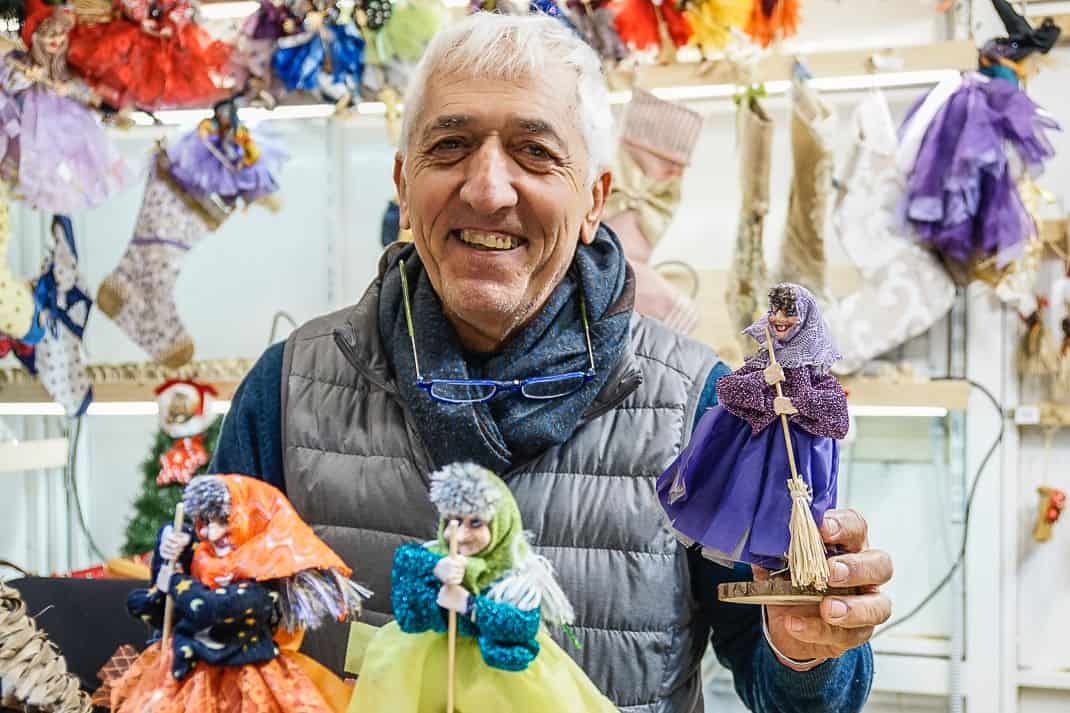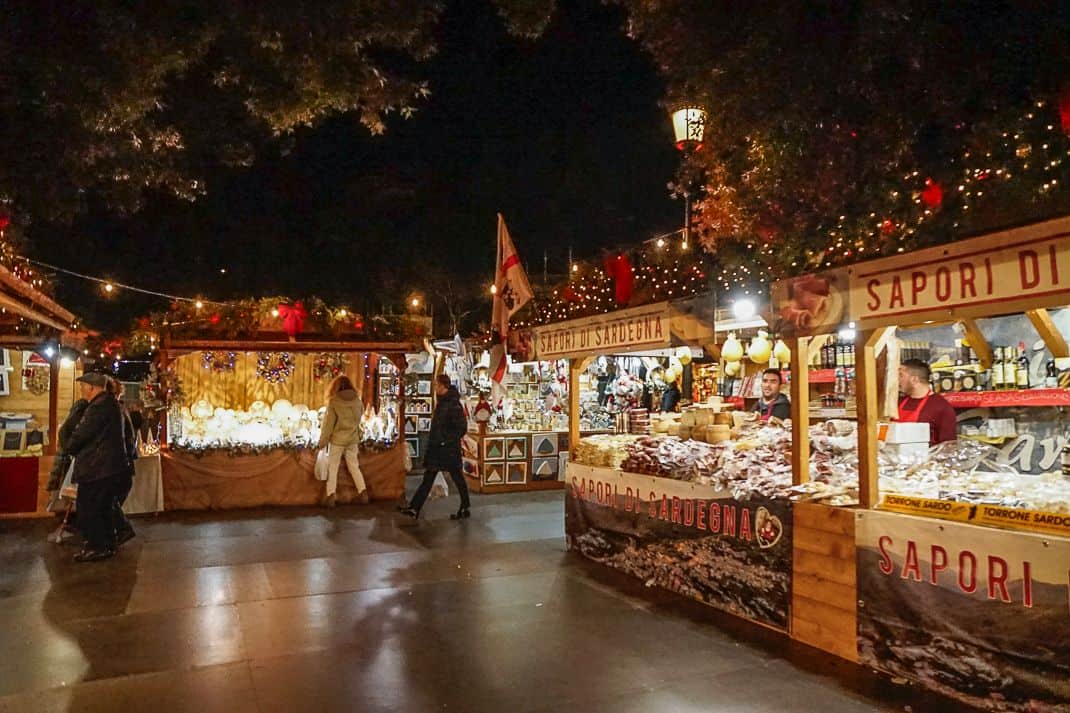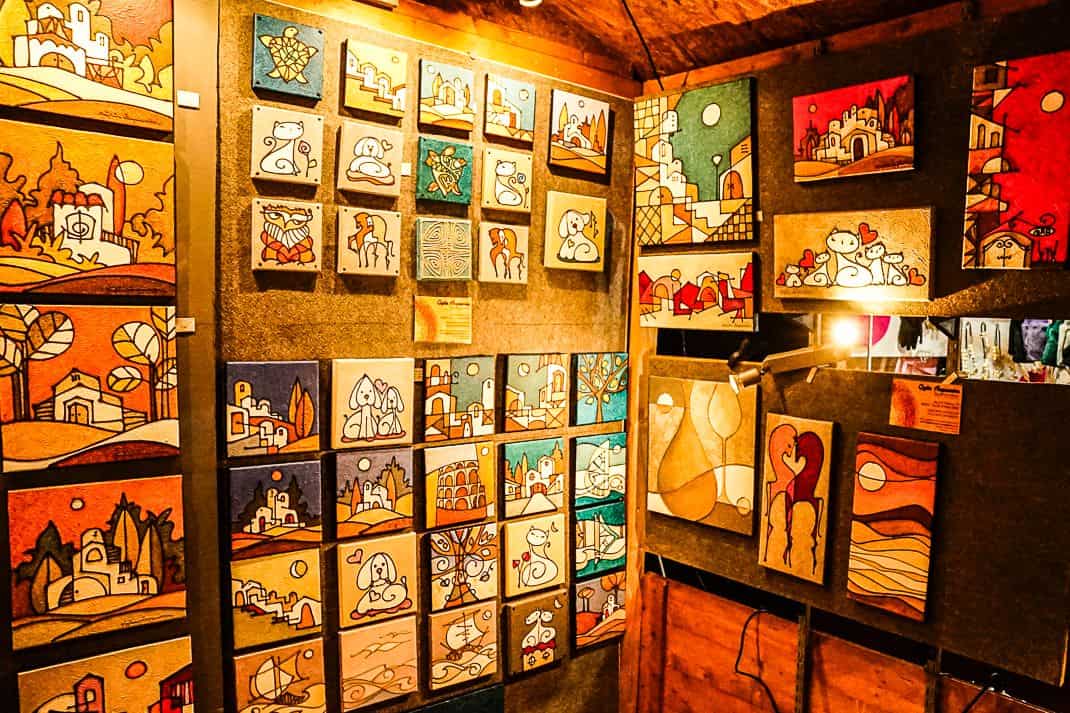Rome Christmas markets: The subtle, romantic way to get into the Christmas spirit far from family

Living in Italy for the last 10 years, I’ve learned to appreciate the spirit of Christmas without hearing Christmas carols before Thanksgiving. The Vatican manages to celebrate Christmas and not adorn St. Peter’s Basilica with red and green lights or plop the pope on Santa’s lap. A giant tree and nativity scene have worked for centuries.
As an American who views Christmas from a more romantic viewpoint, Christmas in Rome has just the right touches. Tasteful lights across Via del Corso. Huge Christmas tree in Piazza Venezia. Subtle red and green trimmings in display windows.
I’ll put on Bing Crosby’s Christmas Classics tape while wrapping Marina’s presents. I eat a lot of torrone, the yummy nougat from the Lombardy town of Cremona that fills shelves every holiday season.

But another great Christmas tradition in Rome is Christmas markets. They aren’t as famous or as elaborate as they are in Germany and Austria but despite no snow anywhere, they get me in the Christmas spirit while 5,700 miles from family.
Marina and I went Christmas market hopping over the weekend, a Rome tradition that goes back to the 19th century. We didn’t buy anything although I dropped a hint that the over wooled socks with the dimpled soles would look good on my feet in January. We mostly booth shopped, fought off urges to eat Christmas goodies and let the Christmas spirit subtly seep into our souls as only Rome knows how.
Rome has many Christmas markets. With apologies to Giftland in the San Paolo neighborhood, Ficus al Massimo at Circus Maximus and Christmas World in Villa Borghese, here are the three we visited:

Laghetto dell’EUR
L’EUR is Benito Mussolini’s ill-fated neighborhood he built with fascist architecture. Big, wide boulevards. Giant buildings with strong columns. Massive windows. Mussolini was hanging by his toes before the neighborhood finished but today it still may be the most modern neighborhood in Rome.
Mussolini also built a man made lake. It was later used as the rowing site for the 1960 Olympics and today you can rent canoes and kayaks on hot summer days.
This month, near the lake is a Christmas market in only its second year. It occupies a large block and ringed with food stalls from around Italy. Sapori di Sardegne had plates with cheese samples. Panini e Fritti had display photos of every kind of pressed sandwich imaginable. A baccala booth had the traditional fried cod.

One seafood place had a small grilled octopus spread out on a giant bun, its eight tentacles lopped over the side.
We passed lots of booths selling jewelry in various levels of beauty, from handmade broaches by artists sitting nearby to junk that certainly read “Made in China” somewhere.
Christmas carols, mostly the rock variety, rang out in the 50-degree air. We passed an ice rink, a site in Southern Italy as rare as a bus arriving on time. For comic relief, watch Romans trying to ice skate. It was mostly children holding hands of their stumbling, struggling middle-age parents who were holding on like they were hanging off a cliff.

Organizers somehow splashed small patches of makeshift snow (Or is that melted ice from the nearby cocktail lounge?) in front of Santa’s “igloo house.” A covered entryway went into a sheltered area where Santa awaited. No line had formed.
Marina and I slipped out and had an aperitivo at the nearby Tiki Bar.
Info: Through Jan. 7, 10 a.m.-9:30 p.m.

Piazza Navona
This is Rome’s most famous and historic Christmas market, not the least because it’s in the famous piazza where they used to hold naval battles during Ancient Rome. Piazza Navona is the site of Rome’s first Christmas market.
In 1477, the huge piazza, measuring 265 by 106 meters, had a food market. As tourism grew in the late 19th century, it merged with the food market in nearby Campo de’ Fiori in 1870 and it still thrives today.
City officials decided to make Piazza Navona into a market only during Christmas. Originally, it was meant for one day: Dec. 8, the date of the Immaculate Conception, the official start of the Italian Christmas season.

However, in this century it began opening as early as Dec. 1 which many Romans said reeked of “crass commercialization.” Artists in the market also complained about foreign goods being sold at cheaper prices. In 2014, then-mayor Ignazio Marino allowed only local artisans and food vendors, saying the market should be about families and less about business. The number of concessions went from 115 to 72.
Many concessionaires boycotted in alliance with their booted colleagues. By 2016 there were only six or seven stalls. The rest of the market was carnival games. No food, toys or crafts. Two years later, it began to grow with a merry-go-round, nativity scene and stage for children’s shows.
In 2019 police closed it down for a lack of permits and it remained closed the next year during Covid.
Monday night, however, the Navona Christmas market was hopping. Many of the stalls, of course, sold souvenirs you can find year round. There were cookbooks in various languages. I saw postcards, including one that was nothing but a marble statue’s dick. Another had coffee mugs of every soccer team in Italy.
Marina pointed to a snack stand that she says is the most traditional. She remembers as a little girl in Rome coming to Piazza Navona and seeing the ciambelle, giant donuts seemingly on steroids. There were long strands of black and red licorice, big hunks of dark chocolate with nuts and, of course, torrone in every variety.

Many booths were stocked with handmade nativity scenes. They’re actually quite beautiful with mother and child huddled in an ancient village, wise men off to the side. I talked to one artist named Alberto Levis who has sold his nativity scenes at Piazza Navona for 15 Christmases. They range from €20-€50.
Growing up in San Giovanni, Rome’s university district, he says it never gets old.
“When I was little I came to the market,” he said. “Now I like to make these for people.”
One booth had little handmade waterfalls where water cascaded down steps lined with moss and little stone houses with short stairs, similar to the homes we see during our day trips around Rome for TraveLazio. All the artisan booths had little befanas, the witch who, according to Italian lore, gives children gifts on the night of Jan. 5, one reason why the markets remain open until then.
Piazza Navona is mostly for children. There’s a merry-go-round, the stage for children’s skits and carnival games where they can work on the all-important children’s skill of shooting a shotgun.
Info: Through Jan. 6.

Christmas Village in Piazza Mazzini
We took a short bus ride to Rome’s best Christmas market. Piazza Mazzini is in the Prati neighborhood about two miles north of the Vatican. The market is located in the square in the middle of a huge roundabout that is the heartbeat of this affluent neighborhood.
The Mazzini Christmas Village has a bit of a mall feel to it. You walk through a giant lit star to enter. But it has by far the most variety and the best shopping. It is chock-a-block with shops.

It is also very Roman. Few tourists know about it. One shop sold nothing but tiny plants, some with hangars. A booth had authentic women’s handbags for €74, a steal in a country where Prada bags go for €34,000.
We passed one artist’s booth where Giglia Acquaviva works with acrylics and … sand. Yes, sand. Her Argentine husband manning the booth, Omar Cornejo, told me she goes to the Tyrrhenian Sea near Rome and gathers sand to make beautiful artwork such as a world relief map.

One shop had gorgeous round placemats decorated with cherries and magnolias. Others had medieval village scenes in various colors.
Clothes. Jewelry. Wool hats. It’s one-stop shopping without the commercialization of a shopping mall.

We finally escaped the 45-degree cold for Moma’s Bistrot, a tiny, neighborhood hole in the wall on the piazza where they had no menus and no spoken English. My chicken meatballs and grilled vegetables were the perfect bow around the Christmas present Marina and I gave ourselves.
Info: Through Dec. 30, 9 a.m.-7:30 p.m.

